Posted: April 26th, 2011 | No Comments »
Marco Polo, who we all thought was an Italian, a Venetian to be precise, appears to be a Croatian…according to the Croatians anyway. And Stepan Mesic, the former President of Croatia, claimed the Chinese asked him to open a new Marco Polo “Memorial Hall” in Yangzhou (more on that here should you be able to work up the enthusiasm – it looks about as historically rigorous as all those Zheng He “museums” and replica boats that have popped up all over in recent years since 1421 massaged the Chinese nationalist soul).
Needless to say the Italians are not best pleased by this “hi-jacking” of their Marco by Croatian nationalists. Realising that they might have strayed into the dangerous waters of Italo-Balkan rivalry (not the sort of thing that ever ends well or without some bloodshed) the Chinese have now backtracked and say they only invited Mesic to attend, not to officiate. Still the ever tin eared local officials are adamant in their hope that the Memorial Hall will “boost and further strengthen Sino-Croatian trade and cultural ties” – obviously we all wish both Yangzhou and Zagreb well with that noble endeavour.
More here from Shanghaiist should you give a sh*t
Shame Yangzhou couldn’t lure the mighty Silvio Berlusconi to town for some Marco-inspired celebratory Bunga Bunga…
 Marco…
Marco…
 and, what we thought was his lovely home town of Venice…
and, what we thought was his lovely home town of Venice…
 But to be honest Zagreb’s none too shabby…
But to be honest Zagreb’s none too shabby…
Posted: April 25th, 2011 | 1 Comment »
Following my last post on Range Road and the Settlement-Paoshan border I wonder if anyone knows what this building was formerly? It is on the southern side of Wujin Road (Range Road), close to the junction with Wusong Road (Woosung Road) and is most intriguing.
As you can see from the pictures below it is not a residential property but I’m not sure it was a theatre/cinema either. The window frames are gothic but not elaborate enough to be a church while the red brick is classic Settlement architecture a la GG Scott and any number of British inspired churches, railway stations or schools. I’m stumped…anyone with a deeper knowledge of Range Road please share….


Posted: April 25th, 2011 | No Comments »
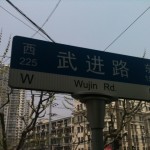 The borders of the Shanghai International Settlement were always contentious – gangsters scuttled across them to evade capture and police argued over territory (heads up – Earnshaw Books are about to reprint EW Peters autobiography Shanghai Policeman from the 1930s which has several fascinating cases of cross border jurisdiction “issues”). To further complicate matters some roads extended from the Settlement to the north and west into Chinese territory – often these properties were owned by foreigners who paid the Shanghai Municipal Council rates for water and electricity. If trouble occurred they could arguably call upon the ratepayer funded Municipal Police too. Therefore, unsurprisingly, the borderlands of the Settlement became areas attracting a vast array of interesting characters – to the west the External Roads Area became better known as the “Badlands” while to the north-east some streets became The Trenches, home to some rather dubious bars and clubs and not a few low-end brothels.
The borders of the Shanghai International Settlement were always contentious – gangsters scuttled across them to evade capture and police argued over territory (heads up – Earnshaw Books are about to reprint EW Peters autobiography Shanghai Policeman from the 1930s which has several fascinating cases of cross border jurisdiction “issues”). To further complicate matters some roads extended from the Settlement to the north and west into Chinese territory – often these properties were owned by foreigners who paid the Shanghai Municipal Council rates for water and electricity. If trouble occurred they could arguably call upon the ratepayer funded Municipal Police too. Therefore, unsurprisingly, the borderlands of the Settlement became areas attracting a vast array of interesting characters – to the west the External Roads Area became better known as the “Badlands” while to the north-east some streets became The Trenches, home to some rather dubious bars and clubs and not a few low-end brothels.
There was also the border, close to the original railway station, between the north of the Settlement and Paoshan (now Boashan). Though, of course, destruction and redevelopment has been extensive around this area the strip of the former border road known as Range Road (now Wujin Road) still contains some great architecture and well-preserved buildings, though to the north of Range Road the destruction is almost total – so probably best to go see Range Road fairly soon if you’re at all interested!!
These lovely apartment buildings along Range Road between Wusong Road (Woosung Road) and Zhapu Road (Chapoo Road) were all constructed in the 1920s to an excellent standard. They still occupy both sides of the block and are in good condition still. Sadly the corner with Sichuan Road North (Szechuan Road North) has been cleared now on all four corners but was once apparently very impressive and the main road out of the Settlement into Paoshan.
Of course if you were a wanted criminal in the Settlement getting in the front door of these buildings and out the back and into Chinese territory basically meant you were free.
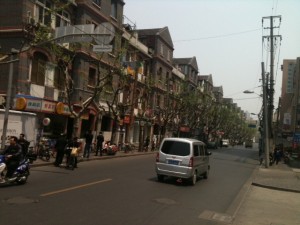

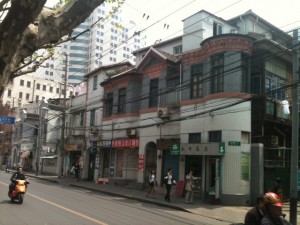
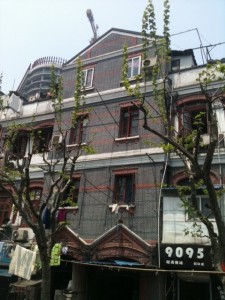
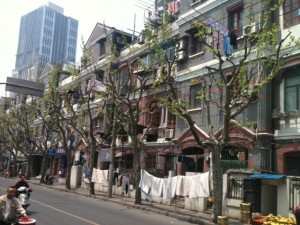
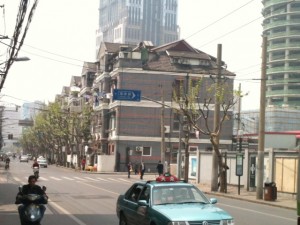
Posted: April 24th, 2011 | No Comments »
A last post from Singapore, and then it’s back to China again next week promise. But, like the Fullerton Bay Hotel I noted the other day, the Waterboat House is another new edition to decent heritage in Singapore. Though I’ve stayed at the nearby Fullerton Hotel (which seems to manage the Waterboat House) I’d never noticed the building before. And it is a building you should notice, previously occupied by the Port of Singapore Authority to sell fresh water to ships anchored in the habour it’s now the usual upmarket restaurant and that, but who cares, it looks good.The original building was a very modern 1919 structure designed by the legendary, and multi-generational, Singapore architects of Swan and Maclaren who’s roster of projects across several generations of the firm include Raffles, the Goodwood Park Hotel (then the Teutonia Club), plenty of churches, department stores and other structures across Singapore.


Posted: April 24th, 2011 | No Comments »
The Elias Building seems to have been restored a bit since I was last in Singapore and so merits a mention. Built in 1928 with three storeys, at the junction of Selegie Road and Middle Road, by the Jewish merchant. It is a lovely example of “stripped” neo-classical with a hint of art-deco from the architects Swan and Maclaren. The building would have been very imposing and modern in the 1920s. The prominent Star of David bas-relief also remains from the original structure and the Elias Building is one of several in Singapore still sporting the Star of David including the Maghain Aboth Synagogue on Warterloo Street. Worth a couple of pics:



Posted: April 23rd, 2011 | No Comments »
Talking of the Fullerton Bay Hotel and the old Clifford Pier – it is not forgotten I’m glad to say even though it is being innovatively used as a hotel now. But back in June 1933 (a hot day as ever in Singapore we can assume) no lesser personage that Sir Cecil Clementi himself (about whom more here), the Governor and Commander-in-Chief of the Straits Settlements turned up to open the Clifford Pier. The pier, by the way, was named after another colonial administrator Hugh Clifford (more on him here). Both men pictured below and the plaque remembering the pier and the day Sir Cecil opened it.

Sir Cecil in his finest…

Clifford – pretty cool as not many people have had a pier named after them!

Posted: April 23rd, 2011 | No Comments »
I’ll break this into two posts if I may – first the old Clifford Pier that is now the Fullerton Bay Hotel.
Here’s how the pier used to look (this shot I assume taken from the roof of the former GPO Building, now the Fullerton Hotel):

And today – from somewhat lower but you get the point:

The hotel has made good use in its lobby of the marvellous iron work supports for the old pier and ferry terminal’s roof:

And the former entrance to the pier is now the entrance to the hotel and rather nice, both during the day…

 And at night…
And at night…
Posted: April 22nd, 2011 | 2 Comments »
Talking of what might become of the Capitol Theatre in Singapore you have to say (as this is Singapore after all) that shopping mall would be top of the list! Hence it is perhaps worth considering the redevelopment of the Cathay cinema when thinking about the potential fate of the Capitol. I used to know the old Cathay before it was redeveloped and loved it then – a terrific 1939 structure that’s now been incorporated into a shopping mall. The facade is protected. The mall is not that exciting to be honest (even by retail park standards!!) though it is a nice arty cinema. Just to show I’m not a complete stick-in-the-mud on preservation I do quite like how this has been done – as you come around the corner from Prinsep Street onto Orchard Road the rounded art deco curves and lovely sand blasted clean stone of the Cathay fair takes your breath away. More details on the history of the Cathay here.

 The Cathay and adjoined mall as is now…and as it was….
The Cathay and adjoined mall as is now…and as it was….
 The car, bottom right, looks suspiciously like a classic Triumph Dolomite but not quite…a free copy of my Old Shanghai A-Z to the first person to tell me the make and model of that car
The car, bottom right, looks suspiciously like a classic Triumph Dolomite but not quite…a free copy of my Old Shanghai A-Z to the first person to tell me the make and model of that car
 and, what we thought was his lovely home town of Venice…
and, what we thought was his lovely home town of Venice… But to be honest Zagreb’s none too shabby…
But to be honest Zagreb’s none too shabby…
























